Mythbusting Ancient Rome - did all roads actually lead there?
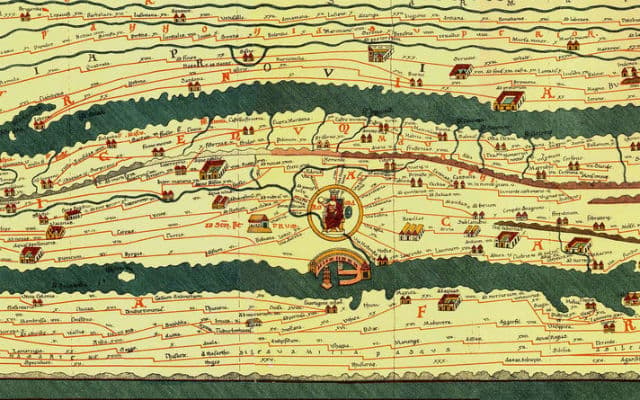
Did all roads really lead to Rome? History lecturers Caillan Davenport and Shushma Malik investigate whether there's any truth behind the proverb.
We all know the phrase “all roads lead to Rome”. Today, it is used proverbially and has come to mean something like “there is more than one way to reach the same goal”. But did all roads ever really lead to the eternal city?
There was a close connection between roads and imperial power. In 27 B.C, the emperor Augustus supervised the restoration of the via Flaminia, the major route leading northwards from Rome to the Adriatic coast and the port of Rimini. The restoration of Italy’s roads was a key part of Augustus’ renovation program after civil wars had ravaged the peninsula for decades. An arch erected on the via Flaminia tells us that it and the most other commonly used roads in Italy were restored “at his own expense”.
And road paving was expensive indeed – it had not been common under the Republic, except in stretches close to towns. Augustus and his successors lavished attention on the road network as roads meant trade, and trade meant money.
In 20 B.C., the senate gave Augustus the special position of road curator in Italy, and he erected the milliarium aureum, or “golden milestone”, in the city of Rome. Located at the foot of the Temple of Saturn in the Roman Forum, it was covered with gilded bronze.
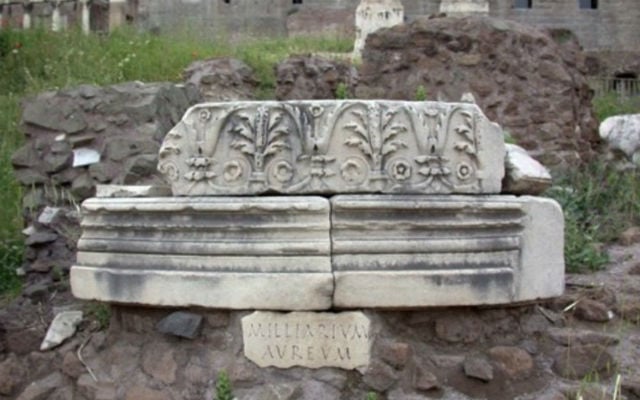 The Golden Milestone. Wikimedia Commons
The Golden Milestone. Wikimedia Commons
According to the ancient biographer Plutarch, this milestone was where “all the roads that intersect Italy terminate”. No one quite knows what was written on it, but it probably had the names of the major roads restored following Augustus’s instructions.
The centre of the world
Augustus was keen to foster the notion that Rome was not just the centre of Italy, but of the entire world. As the Augustan poet Ovid wrote in his Fasti (a poem about the Roman calendar):
There is a fixed limit to the territory of other peoples, but the territory of the city of Rome and the world are one and the same.
Augustus’ right-hand man, Agrippa, displayed a map of the world in his portico at Rome which contained lists of distances and measurements of regions, probably compiled from Roman roads.
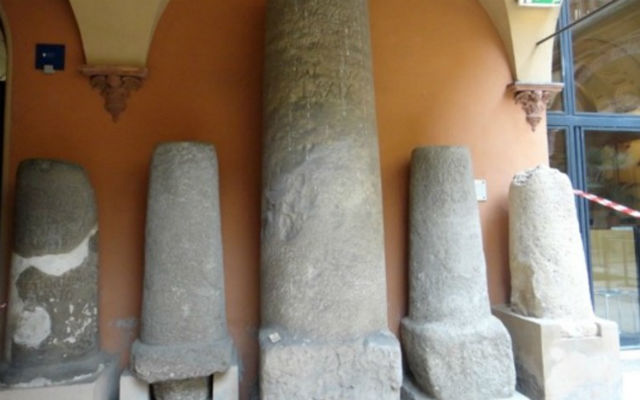
Roman Milestones in the Bologna Archaeological Museum. C Davenport
The Roman road network bound the empire together. Senators had begun to erect milestones listing distances in the mid-third century B.C., but from the first century A.D., emperors took the credit for all road building, even if it had been done by their governors.
More than 7000 milestones survive today. In central Italy, the milestones usually gave distances to Rome itself, but in the north and south, other cities served as the node in their regions.
Augustus also established the cursus publicus, a system of inns and way-stations along the major roads providing lodging and fresh horses for people on imperial business. This system was only open to those with a special permit. Even dignitaries were not allowed to abuse the system, with emperors cracking down on those who exceeded their travel allowances (Bronwyn Bishop would not have fared well in the Roman empire).
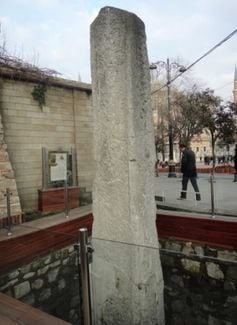
The surviving part of the Milion in Constantinople. C. Davenport
The association between empire and roads meant that when Constantine founded his own “new Rome” at Constantinople in the fourth century A.D., he built an arch called the Milion at its centre, to serve as the equivalent of the Golden Milestone.
Many Roman itineraries have survived because they were copied in the medieval period. These record distances between cities and regions along the Roman road network. The “Antonine Itinerary”, compiled in the third century A.D., even helpfully includes shortcuts for travellers. These types of documents were uniquely Roman – their Greek predecessors had not compiled such itineraries, preferring to publish written accounts of sea voyages.
The Roman road network had prompted the development of new geographical conceptions of power. This is nowhere more prevalent than on the Peutinger Table, a medieval representation of a late Roman map. It positions Rome at the very centre of the known world.
Proverbial roads
Since antiquity, the phrase “all roads lead to Rome” has taken on a proverbial meaning. The Book of Parables compiled by Alain de Lille, a French theologian, in the 12th century is an early example. De Lille writes that there are many ways to reach the Lord for those who truly wish it:
A thousand roads lead men throughout the ages to Rome,
Those who wish to seek the Lord with all their heart.
The English poet Geoffrey Chaucer used the phrase in a similar way in the 14th century in his Treatise on the Astrolabe (an instrument used to measure inclined position):
right as diverse pathes leden diverse folk the righte way to Rome.
The “conclusiouns” (facts) Chaucer translates into English for his son in the treatise come from Greek, Arabic, Hebrew, and Latin - and all came to the same conclusions on the astrolabe, says Chaucer, much as all roads lead to Rome.
In both these examples, while the ancient idea of Rome as a focal point is invoked, the physical city itself is written out of the meaning. Neither de Lille nor Chaucer are actually talking about Rome – our modern “there’s more than one way to skin a cat” would work just as well.
A return to Rome
When the proverb started to become popular in 19th-century newspapers and magazines, however, the spectre of the city returned. Rome as the Eternal City struck a chord with this audience, which was reading and hearing about the exciting excavations taking place in Italy and Europe. Accordingly, the phrase took back a semblance of its original sense – Rome as the imperial metropolis – while retaining its proverbial import.
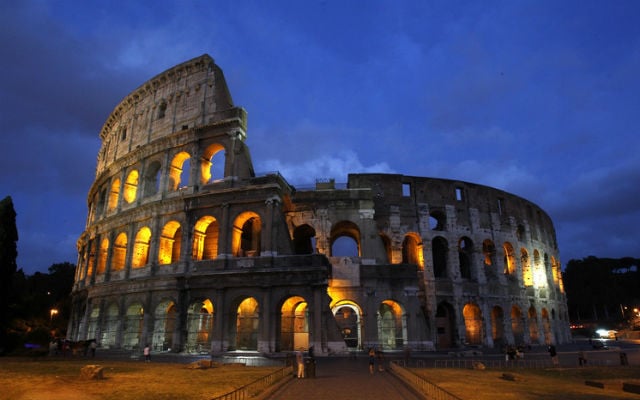 The idea of Rome as The Eternal City has long struck a chord. Tony Gentile/AAP
The idea of Rome as The Eternal City has long struck a chord. Tony Gentile/AAP
For example, in July 1871, the Daily News’s Special Correspondent for the Times in India watched Victor Emmanuel II enter Rome in triumph as the King of (United) Italy:
“All roads,” says the old proverb, “lead to Rome,” and the proverb rose up with a strange force to my mind to-day … By what various paths has he at length reached the Quirinal [Hill].
Just as the King took various roads into the city, so his route to monarchy had been arduous and chequered. The Special Correspondent, on seeing the entrance of Emmanuel II, uses Rome as both an imperial city and an end point for achievement – the King both literally enters the city and takes a number of “roads” to achieve monarchical power. The double use of the proverb is perfect and irresistible.
For other commentators, Rome remained the spiritual centre of the western world. Katherine Walker, writing for Harper’s Magazine in 1865, described her journey from Livorno to Rome with a German Roman Catholic priest.
“We are inclined to think of the old proverb true that ‘All roads lead to Rome’,” she wrote. While the priest delighted in the city as the home of Pope Pius IX, Walker herself objected that her priestly guide could only see the Pantheon as the church Santa Maria ad Martyres, and not as Agrippa’s temple to the pagan gods.
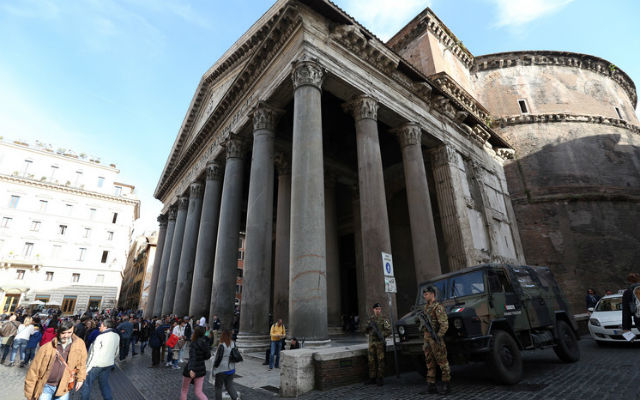
The Pantheon was Agrippa’s temple to the pagan gods. Stefano Rellandini/AAP
While both ancient and modern Italian roads all lead to Rome, to Walker the city itself had drastically mutated from the home of Augustus and Agrippa to that of Catholicism and the Pope. She finds this disappointing.
The idea of Rome
The expression “all roads lead to Rome” is a correct reflection of both the sophisticated Roman road network and its visualisation in Roman monuments and documents.
Later, however, the way in which Romans boasted of the centrality of their metropolis transformed into a proverb that had nothing necessarily to do with real roads or, for a time, the real Rome. In the 19th century, travellers revived the phrase as a way of melding the ancient past with their modern viewing experiences.
Why is this conception of Roman power accurate, when compared with other myths in this series? We assume that Romans were gluttonous or their emperors were crazy because such myths feed into our prejudices, which are then reinforced by popular culture.
 Roads are a much more mundane aspect of Roman life compared to Nero’s alleged excesses, which makes them a less obvious way to think about imperial power. But when we hear the phrase “all roads lead to Rome”, we do not think of paving stones, but of the larger Roman road network - with Rome, its characters, and its history at the centre.
Roads are a much more mundane aspect of Roman life compared to Nero’s alleged excesses, which makes them a less obvious way to think about imperial power. But when we hear the phrase “all roads lead to Rome”, we do not think of paving stones, but of the larger Roman road network - with Rome, its characters, and its history at the centre.
Caillan Davenport, Lecturer in Roman History and ARC DECRA Research Fellow, Macquarie University and Shushma Malik, Lecturer in Classics and Ancient History, The University of Queensland
This article was originally published on The Conversation. Read the original article.
READ MORE: ‘Graffiti in Pompeii and Herculaneum give insight into groups marginalized by history books’
Comments
See Also
We all know the phrase “all roads lead to Rome”. Today, it is used proverbially and has come to mean something like “there is more than one way to reach the same goal”. But did all roads ever really lead to the eternal city?
There was a close connection between roads and imperial power. In 27 B.C, the emperor Augustus supervised the restoration of the via Flaminia, the major route leading northwards from Rome to the Adriatic coast and the port of Rimini. The restoration of Italy’s roads was a key part of Augustus’ renovation program after civil wars had ravaged the peninsula for decades. An arch erected on the via Flaminia tells us that it and the most other commonly used roads in Italy were restored “at his own expense”.
And road paving was expensive indeed – it had not been common under the Republic, except in stretches close to towns. Augustus and his successors lavished attention on the road network as roads meant trade, and trade meant money.
In 20 B.C., the senate gave Augustus the special position of road curator in Italy, and he erected the milliarium aureum, or “golden milestone”, in the city of Rome. Located at the foot of the Temple of Saturn in the Roman Forum, it was covered with gilded bronze.
 The Golden Milestone. Wikimedia Commons
The Golden Milestone. Wikimedia Commons
According to the ancient biographer Plutarch, this milestone was where “all the roads that intersect Italy terminate”. No one quite knows what was written on it, but it probably had the names of the major roads restored following Augustus’s instructions.
The centre of the world
Augustus was keen to foster the notion that Rome was not just the centre of Italy, but of the entire world. As the Augustan poet Ovid wrote in his Fasti (a poem about the Roman calendar):
There is a fixed limit to the territory of other peoples, but the territory of the city of Rome and the world are one and the same.
Augustus’ right-hand man, Agrippa, displayed a map of the world in his portico at Rome which contained lists of distances and measurements of regions, probably compiled from Roman roads.

Roman Milestones in the Bologna Archaeological Museum. C Davenport
The Roman road network bound the empire together. Senators had begun to erect milestones listing distances in the mid-third century B.C., but from the first century A.D., emperors took the credit for all road building, even if it had been done by their governors.
More than 7000 milestones survive today. In central Italy, the milestones usually gave distances to Rome itself, but in the north and south, other cities served as the node in their regions.
Augustus also established the cursus publicus, a system of inns and way-stations along the major roads providing lodging and fresh horses for people on imperial business. This system was only open to those with a special permit. Even dignitaries were not allowed to abuse the system, with emperors cracking down on those who exceeded their travel allowances (Bronwyn Bishop would not have fared well in the Roman empire).

The surviving part of the Milion in Constantinople. C. Davenport
The association between empire and roads meant that when Constantine founded his own “new Rome” at Constantinople in the fourth century A.D., he built an arch called the Milion at its centre, to serve as the equivalent of the Golden Milestone.
Many Roman itineraries have survived because they were copied in the medieval period. These record distances between cities and regions along the Roman road network. The “Antonine Itinerary”, compiled in the third century A.D., even helpfully includes shortcuts for travellers. These types of documents were uniquely Roman – their Greek predecessors had not compiled such itineraries, preferring to publish written accounts of sea voyages.
The Roman road network had prompted the development of new geographical conceptions of power. This is nowhere more prevalent than on the Peutinger Table, a medieval representation of a late Roman map. It positions Rome at the very centre of the known world.
Proverbial roads
Since antiquity, the phrase “all roads lead to Rome” has taken on a proverbial meaning. The Book of Parables compiled by Alain de Lille, a French theologian, in the 12th century is an early example. De Lille writes that there are many ways to reach the Lord for those who truly wish it:
A thousand roads lead men throughout the ages to Rome,
Those who wish to seek the Lord with all their heart.
The English poet Geoffrey Chaucer used the phrase in a similar way in the 14th century in his Treatise on the Astrolabe (an instrument used to measure inclined position):
right as diverse pathes leden diverse folk the righte way to Rome.
The “conclusiouns” (facts) Chaucer translates into English for his son in the treatise come from Greek, Arabic, Hebrew, and Latin - and all came to the same conclusions on the astrolabe, says Chaucer, much as all roads lead to Rome.
In both these examples, while the ancient idea of Rome as a focal point is invoked, the physical city itself is written out of the meaning. Neither de Lille nor Chaucer are actually talking about Rome – our modern “there’s more than one way to skin a cat” would work just as well.
A return to Rome
When the proverb started to become popular in 19th-century newspapers and magazines, however, the spectre of the city returned. Rome as the Eternal City struck a chord with this audience, which was reading and hearing about the exciting excavations taking place in Italy and Europe. Accordingly, the phrase took back a semblance of its original sense – Rome as the imperial metropolis – while retaining its proverbial import.
 The idea of Rome as The Eternal City has long struck a chord. Tony Gentile/AAP
The idea of Rome as The Eternal City has long struck a chord. Tony Gentile/AAP
For example, in July 1871, the Daily News’s Special Correspondent for the Times in India watched Victor Emmanuel II enter Rome in triumph as the King of (United) Italy:
“All roads,” says the old proverb, “lead to Rome,” and the proverb rose up with a strange force to my mind to-day … By what various paths has he at length reached the Quirinal [Hill].
Just as the King took various roads into the city, so his route to monarchy had been arduous and chequered. The Special Correspondent, on seeing the entrance of Emmanuel II, uses Rome as both an imperial city and an end point for achievement – the King both literally enters the city and takes a number of “roads” to achieve monarchical power. The double use of the proverb is perfect and irresistible.
For other commentators, Rome remained the spiritual centre of the western world. Katherine Walker, writing for Harper’s Magazine in 1865, described her journey from Livorno to Rome with a German Roman Catholic priest.
“We are inclined to think of the old proverb true that ‘All roads lead to Rome’,” she wrote. While the priest delighted in the city as the home of Pope Pius IX, Walker herself objected that her priestly guide could only see the Pantheon as the church Santa Maria ad Martyres, and not as Agrippa’s temple to the pagan gods.

The Pantheon was Agrippa’s temple to the pagan gods. Stefano Rellandini/AAP
While both ancient and modern Italian roads all lead to Rome, to Walker the city itself had drastically mutated from the home of Augustus and Agrippa to that of Catholicism and the Pope. She finds this disappointing.
The idea of Rome
The expression “all roads lead to Rome” is a correct reflection of both the sophisticated Roman road network and its visualisation in Roman monuments and documents.
Later, however, the way in which Romans boasted of the centrality of their metropolis transformed into a proverb that had nothing necessarily to do with real roads or, for a time, the real Rome. In the 19th century, travellers revived the phrase as a way of melding the ancient past with their modern viewing experiences.
Why is this conception of Roman power accurate, when compared with other myths in this series? We assume that Romans were gluttonous or their emperors were crazy because such myths feed into our prejudices, which are then reinforced by popular culture.
 Roads are a much more mundane aspect of Roman life compared to Nero’s alleged excesses, which makes them a less obvious way to think about imperial power. But when we hear the phrase “all roads lead to Rome”, we do not think of paving stones, but of the larger Roman road network - with Rome, its characters, and its history at the centre.
Roads are a much more mundane aspect of Roman life compared to Nero’s alleged excesses, which makes them a less obvious way to think about imperial power. But when we hear the phrase “all roads lead to Rome”, we do not think of paving stones, but of the larger Roman road network - with Rome, its characters, and its history at the centre.
Caillan Davenport, Lecturer in Roman History and ARC DECRA Research Fellow, Macquarie University and Shushma Malik, Lecturer in Classics and Ancient History, The University of Queensland
This article was originally published on The Conversation. Read the original article.
READ MORE: ‘Graffiti in Pompeii and Herculaneum give insight into groups marginalized by history books’
Join the conversation in our comments section below. Share your own views and experience and if you have a question or suggestion for our journalists then email us at [email protected].
Please keep comments civil, constructive and on topic – and make sure to read our terms of use before getting involved.
Please log in here to leave a comment.